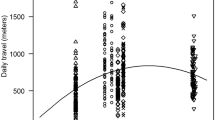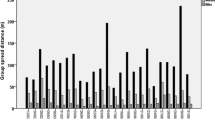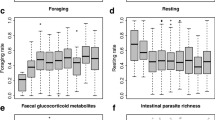Summary
A comparison of data on ranging, activity budgets and frequencies of social behaviour gathered over a range of group sizes for an omnivorous, forest-living monkey, the long-tailed macaque (Macaca fascicularis), showed that the length of the day journey, the time spent travelling and searching for dispersed food items, as well as social tension, show a monotonic increase with group size. A behavioural mechanism behind these patterns is the “puhing forward” effect: foraging animals tend to move away when approached by others, presumably because they reduce the availability of dispersed food items in patches they have searched. By avoiding being overtaken animals are not forced to search in depleted patches. An alternative mechanism, the limited capacity of fruit trees, does not operate in the present case. It is concluded that theories postulating feeding advantages to be the primary factor favouring group living do not apply in this case.
Similar content being viewed by others
References
Aldrich-Blake FPG (1980) Long-tailed macaques. In: Chivers DJ (ed) Malayan forest primates. Plenum Press, New York, pp 147–165
Alexander RD (1974) The evolution of social behavior. Annu Rev Ecol Syst 5:325–383
Altmann J (1974) Observational study of behavior: sampling methods. Behaviour 49:227–267
Bertram BCR (1978) Living in groups: predators and prey. In: Krebs JR, Davies NB (eds) Behavioural ecology. Blackwell, Oxford, pp 64–96
Chepko-Sade BD, Sade DS (1979) Patterns of group splitting within matrilineal kinship groups: a study of social group structure in Macaca mulatta. Behav Ecol Sociobiol 5:67–86
Clutton-Brock TH (1974) Primate social organization and ecology. Nature 250:539–542
Cody ML (1971) Finch flocks in the Mohave desert. Theor Popul Biol 2:142–158
Colquhoun D (1971) Lectures on biostatistics. Clarendon Press, Oxford
Eisenberg JF, Muckenhirn NA, Rudran R (1972) The relation between ecology and social structure in Primates. Science 176:863–874
Freeland WJ (1976) Pathogens and the evolution of primate sociality. Biotropica 8:12–24
Hamilton WD (1971) Geometry for the selfish herd. J Theor Biol 31:295–311
Hoogland JL (1981) The evolution of coloniality in white-tailed and black-tailed prairie dogs (Sciuridae: Cynomys leucurus and C. ludovicianus). Ecology 62:252–272
Hoogland JL, Sherman PW (1976) Advantages and disadvantages of bank swallow (Riparia riparia) coloniality. Ecol Monogr 46:33–58
Horn HS (1968) The adaptive significance of colonial nesting in the Brewer's blackbird. Ecology 49:682–694
Jonckheere AR (1954) A distribution-free k-sample test against ordered alternatives. Biometrika 41:133–145
Krebs JR, Davies NB (1981) An introduction to behavioural ecology. Blackwell, Oxford
Kurland JA (1973) A natural history of kra macaques (Macaca fascicularis Raffles 1821) at the Kutai Reserve, Kalimantan Timur, Indonesia. Primates 14:245–262
Mitani JC, Rodman PS (1979) Territoriality: the relation of ranging pattern and home range size to defendability, with an analysis of territoriality among primate species. Behav Ecol Sociobiol 5:241–251
Pulliam HR (1973) On the advantages of flocking. J Theor Biol 38:419–422
Raemaekers JJ, Chivers DJ (1980) Socio-ecology of Malayan forest primates. In: Chivers DJ (ed) Malayan forest primates. Plenum Press, New York, pp 279–316
Rijksen HD (1978) A field study of Sumatran Orang-Utans (Pongo pygmaeus abeli Lesson 1827). Veenman, Wageningen
Schaik CP van (in press) Why are diurnal primates living in groups? Behaviour
Schaik CP van, Noordwijk MA van, Warsono B, Sutriono E (1983) Party size and early detection of predators in Sumatran forest primates. Primates 24:211–221
Schoener TW (1971) Theory of feeding strategies. Annu Rev Ecol Syst 2:369–404
Siegel S (1956) Non-parametric statistics for the social sciences. McGraw-Hill, New York
Taylor RJ (1977) Value of clumping to prey and the evolutionary response of ambush predators. Am Nat 110:13–29
Treisman M (1975) Predation and the evolution of gregariousness I: models for concealment and evasion. Anim Behav 23:779–800
Waal FBM de, Hooff JARAM van, Netto WJ (1976) An ethological analysis of types of agonistic interactions in a captive group of Java-monkeys (Macaca fascicularis). Primates 17:257–290
Ward P, Zahavi A (1973) The importance of certain assemblages of birds as ‘information-centres’ for food-finding. Ibis 115:517–534
Waser P (1977) Feeding, ranging and group size in the mangabey, Cercocebus albigena. In: Clutton-Brock TH (ed) Primate ecology. Academic Press, London, pp 183–222
Wheatley BP (1980) Feeding and ranging of East Bornean Macaca fascicularis. In: Lindburg DG (ed) The macaques. Van Nostrand Reinhold, New York, pp 215–246
Wrangham RW (1979) On the evolution of ape social systems. Soc Sci Inf 18:335–368
Wrangham RW (1980) An ecological model of female-bonded primate groups. Behaviour 75:262–300
Author information
Authors and Affiliations
Rights and permissions
About this article
Cite this article
van Schaik, C.P., van Noordwijk, M.A., de Boer, R.J. et al. The effect of group size on time budgets and social behaviour in wild long-tailed macaques (Macaca fascicularis). Behav Ecol Sociobiol 13, 173–181 (1983). https://doi.org/10.1007/BF00299920
Received:
Accepted:
Issue Date:
DOI: https://doi.org/10.1007/BF00299920




